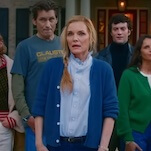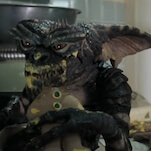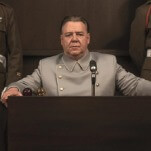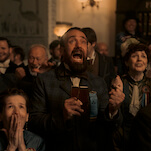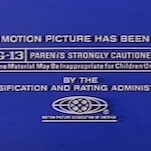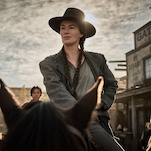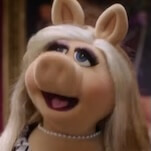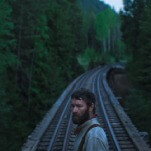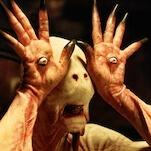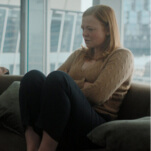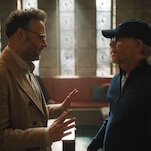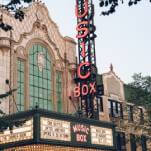Thursday, November 23rd
Brick (commercial DVD): This one I've been anxious to see since it debuted at Sundance in 2005, and it wasn't quite what I'd expected. I was figuring this "high school noir" was going to be shot like a conventional noir, with long shadows and shafts of light, and that it was going to be more comic. And while Brick is funny at times–in a Coen Brothers, snappy-archaic-patter kind of way–in style it resembles the artfully shot Amerindies of today, with a drop or two of post-Tarantino pulp gimmickry. The score is spare and evocative, the performances muted and mumbly, and the locations mundane and spookily deserted. What I liked best about the movie were those locations, which were familiar suburban landscapes cast in that late-afternoon light when school's out but parents are still at work–when teenagers roam the Earth unchecked. What I liked least was that writer-director Rian Johnson didn't do enough with the "high school as pulp" idea. There's a scene late in the film where one of the hero's sources of information talks about how tight they used to be when they were freshmen, and that moment hints at an area Johnson could've explored more: the way that kids change as their school years play out, and become harder versions of who they used to be. That's a central noir theme: what we were versus what we are. But Johnson kind of lets that go, just as he lets go the study of the high school caste system that he half-starts, before getting sidetracked by a typically twisty noir plot. (Can I confess something? I love noir, but I hate noir plots. This is a subject for another blog post sometime.) All of that said, I enjoyed the heck out of what Brick is, even when I wished it were something else.
Grade: B+
On the list? Another near-miss, angling for the HMs.
Friday, November 24th
The Fountain (commercial screening): I can understand why some people hate this movie–it is quasi-mystical, over-earnest and hyper-nerdy–and I can't exactly blame them. But even though I have no idea what the hell everything meant, I quite liked The Fountain. It's in the vein of one of those brainy, abstract short stories that show up in the better sci-fi anthologies, and if there were a lot of movies that drew inspiration from that genre, I might be more inclined to nitpick this one. But there just aren't, which makes The Fountain's ambition all the more admirable. Gotta give it up for Darren Aronofsky's visual imagination, too, which somehow finds analogues between metastasizing brain tumors, tree roots, exploding stars, a map of historical Spain detailing the spread of the Inquisition, and the human birth canal. Goofy The Fountain may be, but under-thought it is not. And though the race-to-cheat-death/consequences-of-human-arrogance themes never resolved in any comprehensible way (at least not that I could see), I found Hugh Jackman's fear of loss very moving, and I generally thought he acquitted himself well, even when asked to express a kind of transcendent pain/joy that would make nearly any actor look foolish. It's got all kinds of problems, but I dug this scrappy little movie.
Grade: B
On the list? No. I'd like to, but I can't. Still, part of me wonders if 2006 will be remembered someday as the year of The Fountain and Marie Antoinette, not Little Miss Sunshine and Babel.
Saturday, November 25th
Friends With Money (commercial DVD): People were generally underwhelmed by this Nicole Holofcener comedy, but then people were underwhelmed by her Lovely & Amazing too, and that was one of my favorite movies of 2001. Friends With Money is no Lovely & Amazing, but it's a nice addition to the Holofcener-verse: A shaggy set of interlocking relationship comedies set among the Los Angeles nouveau riche. Some of the confrontations are a little forced, and yes, the movie's a little sitcom-y; but Friends With Money would be the best-written sitcom on TV, if it were on TV. Holofcener gets what it's like to try to be a grown-up when you don't feel the least bit responsible, and she understands the awkwardness of certain social conventions, like the way talking about money is at once expected and frowned upon in the same circles, and how it's hard to care about the less fortunate when you're not sure who really qualifies. The best things about Friends With Money are the little bits of business the characters run through almost unconsciously: Joan Cusack working out, Jennifer Aniston procuring and using beauty products, Catherine Keener bickering with her husband, and Frances McDormand getting so mad about petty social injustices that she walks right into a glass door at an Old Navy and breaks her nose. Quoth Keener: "What's even weirder is that she hates Old Navy."
Grade: B+
On the list? Another one jockeying for the HMs.
Old Joy (DVD-R): A lovely, haunting little movie about old friends and feigned allegiances. Given how engaging Will Oldham is as the free-spirited drifter who tries to reconnect with an old roommate–now married, with a demanding job and a kid on the way–I wish there'd been more actual conversation, and maybe a few more hard facts about who these guys are. But director Kelly Reichardt keeps everything vague and impressionistic on purpose, to allow a way in for anyone who's ever known someone like Oldham, still living like he's a college student and seemingly on the brink of breaking down. And Reichardt wants us to feel what it's like to hike slowly through a quiet forest, unsure whether you should be talking or just appreciating. It's a risky strategy, making most of the action of the movie internal, and letting it play out on the faces of two non-pro actors. But it mostly works, and the subtleties of Old Joy–from the talk radio commentary about a weakened Democratic Party and the differences between "recovery" and "prosperity," to the way Oldham's anecdotes about his hippie happenings cause his friend's face to fall, either out of disgust with the pointless decadence or disappointment that he wasn't there–gradually begin to clarify. The best scene in the movie is one of the last, as the two men sit in a tub at a hot spring, not entirely sure if they're having a good time or not, and not entirely sure if they'd both rather be experiencing this alone.
Grade: A-
On the list? Tentatively, yes. Slide it in at #8, and move everything else down, bumping The Devil & Daniel Johnsoton to the HM.




















